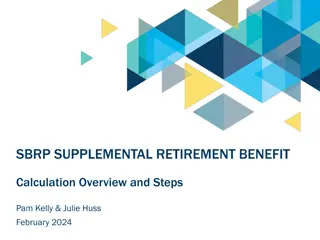The Importance of Benefit-Cost Analysis in Decision Making
Benefit-Cost Analysis (BCA) is a crucial tool in decision-making processes, particularly in political and governmental spheres. It allows for the evaluation of whether the benefits of a proposed change outweigh its costs, aiding in the selection of the most efficient and profitable options. BCA is widely used in various sectors, including by the European Commission in assessing major projects for funding. The framework involves considering opportunity costs, long-term perspectives, economic performance indicators, and the macroeconomic impact of decisions. Its application helps in resource allocation and enhancing societal welfare.
Download Presentation

Please find below an Image/Link to download the presentation.
The content on the website is provided AS IS for your information and personal use only. It may not be sold, licensed, or shared on other websites without obtaining consent from the author. Download presentation by click this link. If you encounter any issues during the download, it is possible that the publisher has removed the file from their server.
E N D
Presentation Transcript
The Importance of Benefit Cost Analysis in decisionmaking Kristina Gogi , mag.iur./LLM
BCA is simply rational decision-making BCA is yet controversial regulatory tool (people use it every day projects, programmes, policy proposals, any kind of economic decision, etc.) BCA is relatively simple and widely technique for deciding whether to make a change (2*) BCA is very important in political, Governmental decisions, European Commission decisions An individual might be satisfied with an emotional or ad hoc response; Governmental body must be very careful and cannot rely on such reactions Governments are using BCA very often - successful decision when total expected costs are less than total expected benefits (5*) - results with the most profitable option BCA might be the most efficient decision framework; in efficiency terms (6*)
BCA is simply rational decision-making Each analysis is different and demands careful and innovative thought If there is a single decision maker than an analysis from one point of view is often adequate (individual aproach in decisionmaking) If the interests of more than one person or group are affected, the several analysis might be necessary (dual or group aproach in decision making) (3*)
BCA in the framework of EU Funds: European Commission decision a basis for decisionmaking on the co-financing of major projects included in operational programs (Ops) of the ERDF and CF Since 2007. the level of investments in EU dropped off by about 15% as a consequence of the economic and financial crisis (debt crisis, unemployment) (1*) EC made Strategy for Europe 2020. through guide to BCA of Investments projects (2014.-2020.) (2*) EC made EU Investment Plan for the period 2015.-2017. BCA is an analytical tool for judging the economic advantages od disadvantages of an investment decision by assessing it s costs and benefits in order to assess the welfare change attributable to it The purpose of BCA - to facilitate a more efficient allocation of resources demonstrating the convenience to society of a particular intervention rather than possible alternatives The legal basis for major projects appraisal is Regulation 1303/2013 of European Parliament and Council (EUR-Lex web site) (6*)
BCA in the framework of EU funds BCA (including an economic and an financial analysis including risk assessment) is one of the very important information required for the approval of a major project (1*) The analytical framework of BCA refers to a list of underlying concepts: - oportunity costs - long term perspective (min. 10 years max. 30 years or more depending of the sector of intervention): a) set a proper time horizon b) forecast future costs and benefits (looking forward) c) adopt appropriate discount rates to calculate the present value of future costs and benefits d) take into account uncertainty to assessing the project risks - calculation of eceonomic performance indicators expressed in monetary terms (2*III) - macroeconomic approach; BCA is typically a macroeconomic approach enabling the assessment of the projects impact on society as a whole via the calculation of economic performance indicators, thereby providing an assessment of expected welfare changes (2*IV)
Standard BCA Project appraisal steps 1. Description of the context; presentation of the socio-economic, institutional and political context; - the socio-econimc conditions of the county/region that are relevant for the project, including e.g. demographic dynamics, expected GDP growth, labour market conditions, unemployment trend etc. - the policy and institutional aspects, including existing economic policies and development plans, organisation and management of services to be provided/developed by the project as well as capacity and quality of the institutions involved - the current infrastructure endowment and service provision, including indications/data on coverage and qualities of service provides, current operating costs and tariffs/fees/charges paid by users, if any - other information and statistics that are relevant to better quality the context, for instance, existence of environmental authorities likely to be involved, etc. - the perception of the expectation of the population with relation to the service to be provided including, when relevant, the positions adopted by civil society organisations
Standard BCA Project appraisal steps 2. Definition of the objectives; needs assessment, project relevance - identify of the effects of the project to be further evaluated to BCA; the identification of the effects should be linked to the project objectives in order to measure the impact of welfare; the clearer the definition of objectives, the easier identification of the project and it s effects; objectives are highly relevant for the BCA which should reveal to what extent they are met (1*I) -verify the project relevance; evidence should be provided that the project s rational responds to a priority for the territory; this is achieved by checking that the project contributes to reaching the EU policy goals and national/regional long term development plans in the specific sector of assistance (1*II) 3. Identification of the project; project activities; body responsible for project implementation; who was standing -a project is defined as a series of works, activities or services intended in itself accomplished and invisible task of a precise economic and technical nature which has clearly identify goals (Art. 100 of the Regulation 1303/2013) - the project owner is the body responsible for project implementation should be identified and described in terms of it s technical, financial and institutional capacity - who was standing should account for all stakeholders who are significantly affected by the costs and benefits of the project
Standard BCA Project appraisal steps 4. Technical flexibility & Environmental sustainability; Demand analysis; Option analysis; Environmental considerations, including Environmental Impact Assessment and climate change; Technical design, Cost estimates and implementation schedule (1*) - demand analysis identifies the need for an investment by assessing: a) current demand (based on statistics provided by service suppliers/regulators/national and regional statistical offices for the various types of users) b) future demand (based on reliable forecasting models that take into consideration macro and socio-economic forecasts, alternative sources of supply, elasticity of demand to relevant prices and income) - strategic option analysis; once the strategic option is identified, a comparison of the specific technological solutions is typically carried out (1*I)
Standard BCA Project appraisal steps - environmental and climate change considerations; important regulations, agreement; a) scope of Strategic environmental assessment (SEA) 2001/42/EC b) Council Directive 2014/52/EU on Environmental Impact Assessment (EIA) must be carried out to identify, describe and assess the direct and indirect of the project on human beigns and the environmental c) Paris Agreement; December 2015., 195 countries adopted first- ever universal, legally binding global climate deal (1*II) d) while the EIA is formally distinct and self-standing procedure, its outcomes need to be integrated in the BCA and be in the balance when choosing the final project option (1*III) (1*IV) (1*IV/1) - technical design, cost estimates and implementation schedule; a summary of the proposed project shall be presented with the following headings (1*V)
Standard BCA Project appraisal steps 5. Financial analysis; (financial discount rate recommended by EC is 4% in real terms), cash flows for project costs and revenues, including residental value; tariff and affordability analysis (where relevant); sources of financing; financial profitability & sustainability - fiscal corrections; taxes and subsides are transfer payments (have to be in prices) that do not represent real economic costs or benefits for society as they involve merely a transfer of control over certain resources from one group in society to another (1*I) - conversion from market to shadow prices - evaluation of non-market impacts Sources of financing: - union assistance (EU grant) - national public contribution - project promoter s contribution - private contribution under PPP (public private partnership)
Standard BCA Project appraisal steps Financial sustainability; the project is financial sustainalbe when the risk of running out of cash in the future, both during the investment and the operational stages, is expected to be nil. Risk assessment is included in BCA as one of the important information necessary for the approval of the major project; this is required to deal with the uncertainty that always permeates investment projects, including the risk that the adverse impacts of climate change may have on the project. (1*I) Project risks recommended steps: - sensitivity analysis enables the identification of the critical variables of the project (1*II); before proceeding to the sensitivity analysis, the BCA model should be reviewed with the aim of isolating the independent variables eliminating the deterministic interdependencies (e.g. splitting a variable in its independent components) (1*II/I)
Standard BCA Project appraisal steps - the quantitative risk analysis aims shell include the following elements; a) a list of adverts events to which the project is exposed b) a risk matrix for each adverse event indicating: - the possible causes of occurrence - the link with the sensitivity analysis, where applicable - the negative effects generated on the project - the (ranked) levels of probability of occurrence and of the severity of impact - the risk level c) an interpretation of the risk matrix including the assessment of acceptable levels of risk d) a description of mitigation and/or prevention neasures for the main risks, indicating who is responsible for the applicable measures to reduce risk exposure, when they are considered necessary
Standard BCA Project appraisal steps - probabilistic risk analysis; according to the BCA methodology, the probabilistic risk analysis is required where the residual risk exposure is still significant; in other cases it may be carried out where appropriate, depending on project size and data availability - risk prevention and mitigation; the implementation of the steps described above defines the risk prevention and mitigation strategy of the project
Thank you on your attention E-mail: kristinagogic1@gmail.com kristina.gogic@ombudsman.hr

















































